Security Aspects of Blockchain Technology Intended for Industrial Applications
Abstract
1. Introduction
2. Blockchain Technology
2.1. Evolution of Blockchain
2.2. Classification of Blockchain
2.2.1. Public Blockchain
2.2.2. Private Blockchain
2.2.3. Consortium Blockchain
2.3. Components and Working of Blockchain
2.3.1. Block
2.3.2. Hash Pointer
2.3.3. Merkle Tree
2.3.4. Digital Signature
2.3.5. Transactions
2.3.6. Consensus Mechanism
2.3.7. Inner Working of a Blockchain-Based System
3. Security Traits of Blockchain-Based Systems
3.1. Consistent Data
3.2. Tamper-Resistant Data
3.3. Pseudonymized Network
3.4. Distributed Denial of Service Attacks-Resistant Network
3.5. Secure and Confidential Data
4. Security and Privacy Methods Used in Blockchain-Based Systems
4.1. Anonymous Digital Signatures
4.2. Mixing
4.3. Homomorphic Encryption Algorithms
4.4. Secure Multiparty Computation Protocol
4.5. Attribute Based Encryption Algorithm
4.6. Non Interactive Zero-Knowledge Proof System
5. Blockchain-Based Industrial Applications
5.1. Supply Chain
5.2. Healthcare
5.3. Internet of Things (IoT)
5.4. Governance
5.5. Finance
5.6. Manufacturing Business
6. Concluding Remarks
Author Contributions
Funding
Acknowledgments
Conflicts of Interest
References
- Aste, T.; Tasca, P.; Di Matteo, T. Blockchain technologies: The foreseeable impact on society and industry. Computer 2017, 50, 18–28. [Google Scholar] [CrossRef]
- Nakamoto, S. Bitcoin: A Peer-to-Peer Electronic Cash System. 2019. Available online: https://bitcoin.org/bitcoin.pdf (accessed on 11 February 2012).
- Xie, S.; Zheng, Z.; Chen, W.; Wu, J.; Dai, H.-N.; Imran, M. Blockchain for cloud exchange: A survey. Comput. Electr. Eng. 2020, 81, 106526. [Google Scholar] [CrossRef]
- Al-Jaroodi, J.; Mohamed, N. Blockchain in industries: A survey. IEEE Access 2019, 7, 36500–36515. [Google Scholar] [CrossRef]
- Crosby, M.; Pattanayak, P.; Verma, S.; Kalyanaraman, V. Blockchain technology: Beyond bitcoin. Appl. Innov. 2016, 2, 6–10. [Google Scholar]
- Lu, Y. Blockchain and the related issues: A review of current research topics. J. Manag. Anal. 2018, 5, 231–255. [Google Scholar] [CrossRef]
- Kan, L.; Wei, Y.; Muhammad, A.H.; Siyuan, W.; Gao, L.C.; Kai, H. A multiple blockchains Architecture on Inter-Blockchain Communication. In Proceedings of the 2018 IEEE International Conference on Software Quality, Reliability and Security Companion (QRS-C), Lisbon, Portugal, 16–20 July 2018; pp. 139–145. [Google Scholar]
- Idrees, S.M.; Aijaz, I.; Agarwal, P.; Jameel, R. Transforming Cybersecurity Solutions using Blockchain; Blockchain Technologies; Springer: Singapore, 2021; pp. 165–183. [Google Scholar] [CrossRef]
- CoinMarketCap. Cryptocurrency Market Capitalizations. 2017. Available online: https://coinmarketcap.com/ (accessed on 12 November 2020).
- Zhang, Y.; Wen, J. The IoT electric business model: Using blockchain technology for the internet of things. Peer-to-Peer Netw. Appl. 2017, 10, 983–994. [Google Scholar] [CrossRef]
- Sun, J.; Yan, J.; Zhang, K.Z.K. Blockchain-based sharing services: What blockchain technology can contribute to smart cities. Financial Innov. 2016, 2, 26. [Google Scholar] [CrossRef]
- Ekblaw, A.; Azaria, A.; Halamka, J.D.; Lippman, A. A Case Study for Block Chain in Healthcare: Medrec Prototype for Electronic Health Records and Medicalresearch Data. 2016. Available online: https://www.media.mit.edu/publications/medrecwhitepaper/ (accessed on 12 November 2020).
- Idrees, S.M.; Aijaz, I.; Agarwal, P.; Jameel, R. Exploring the Blockchain Technology: Issues, Applications and Research Potential. Int. J. Online Biomed. Eng. 2021, in press. [Google Scholar]
- Bylica, P.; Gleń, Ł.; Janiuk, P.; Skrzypczak, A.; Zawłocki, A. A Probabilisticnanopayment Scheme for Golem. 2015. Available online: http://golemproject.net/doc/GolemNanopayments.pdf (accessed on 12 October 2020).
- Hurich, P. The virtual is real: An argument for characterizing bitcoins as private property. In Banking & Finance Law Review; Carswell Publishing: Toronto, ON, Canada, 2016; Volume 31, p. 573. [Google Scholar]
- Xu, X.; Pautasso, C.; Zhu, L.; Gramoli, V.; Ponomarev, A.; Tran, A.B.; Chen, S. The blockchain as a software connector. In Proceedings of the 13th Working IEEE/IFIP Conferenceon Software Architecture, Venice, Italy, 5–8 April 2016. [Google Scholar]
- Czepluch, J.S.; Lollike, N.Z.; Malone, S.O. The Use of Block Chain Technology in Different Application Domains; The IT University of Copenhagen: Copenhagen, Denmark, 2015. [Google Scholar]
- Idrees, S.M.; Nowostawski, M.; Jameel, R. Blockchain-based digital contact tracing apps for COVID-19 pandemic management: Issues, challenges, solutions, and future directions. JMIR Med. Inform. 2021, 9, e25245. [Google Scholar] [CrossRef]
- Fusco, A.; Dicuonzo, G.; Dell’Atti, V.; Tatullo, M. Blockchain in healthcare: Insights on COVID-19. Int. J. Environ. Res. Public Heal. 2020, 17, 7167. [Google Scholar] [CrossRef]
- Nandi, S.; Sarkis, J.; Hervani, A.A.; Helms, M.M. Redesigning supply chains using blockchain-enabled circular economy and COVID-19 experiences. Sustain. Prod. Consum. 2021, 27, 10–22. [Google Scholar] [CrossRef]
- Chang, S.E.; Chen, Y.; Lu, M.; Luo, H.L. Development and Evaluation of a Smart Contract–Enabled Blockchain System for Home Care Service Innovation: Mixed Methods Study. JMIR Med. Inform. 2020, 8, e15472. [Google Scholar] [CrossRef]
- Pan, X.; Pan, X.; Song, M.; Ai, B.; Ming, Y. Blockchain technology and enterprise operational capabilities: An empirical test. Int. J. Inf. Manag. 2020, 52, 101946. [Google Scholar] [CrossRef]
- Christidis, K.; Devetsikiotis, M. Blockchains and smart contracts for the internet of things. IEEE Access 2016, 4, 2292–2303. [Google Scholar] [CrossRef]
- Peck, M.E. Blockchains: How they work and why they’ll change the world. IEEE Spectr. 2017, 54, 26–35. [Google Scholar] [CrossRef]
- Idrees, S.M.; Alam, M.A.; Agarwal, P.; Ansari, L. Effective Predictive Analytics and Modeling Based on Historical Data. In Proceedings of the Advances in Service-Oriented and Cloud Computing, Taormina, Italy, 15–17 September 2015; Springer: Singapore, 2016; pp. 552–564. [Google Scholar]
- Available online: https://www.ibm.com/blockchain (accessed on 12 November 2020).
- Available online: https://azure.microsoft.com/en-in/services/blockchain-service/#:~:text=Azure%20Blockchain%20Service%20is%20integrated%20with%20Microsoft%20serverless%20and%20codeless%20development%20tools.&text=Using%20the%20Visual%20Studio%20Code%20extension%2C%20write%2C%20test%2C%20debug,or%20to%20public%20blockchain%20networks (accessed on 12 October 2020).
- Available online: https://cloud.google.com/customers/blockchain (accessed on 12 October 2020).
- Available online: https://aws.amazon.com/managed-blockchain/#:~:text=Amazon%20Managed%20Blockchain%20is%20a%20fully%20managed%20service%20that%20allows,with%20just%20a%20few%20clicks.&text=Once%20your%20network%20is%20up,and%20maintain%20your%20blockchain%20network (accessed on 12 November 2020).
- Homayoun, S.; Dehghantanha, A.; Ahmadzadeh, M.; Hashemi, S.; Khayami, R. Know abnormal, find evil: Frequent pattern mining for ransomware threat hunting and intelligence. IEEE Trans. Emerg. Top. Comput. 2017, 8, 341–351. [Google Scholar] [CrossRef]
- Osanaiye, O.; Cai, H.; Choo, K.-K.R.; Dehghantanha, A.; Xu, Z.; Dlodlo, M. Ensemble based multi-filter feature selection method for DDoS detection in cloud computing. EURASIP J. Wirel. Commun. Netw. 2016, 2016, 1–10. [Google Scholar] [CrossRef]
- Bonneau, J.; Miller, A.; Clark, J.; Narayanan, A.; Kroll, J.A.; Felten, E.W. SoK: Research Perspectives and Challenges for Bitcoin and Cryptocurrencies. In Proceedings of the 2015 IEEE Symposium on Security and Privacy, San Jose, CA, USA, 18–20 May 2015; pp. 104–121. [Google Scholar]
- Conti, M.; Kumar, E.S.; Lal, C.; Ruj, S. A survey on security and privacy issues of bitcoin. IEEE Commun. Surv. Tutor. 2018, 20, 3416–3452. [Google Scholar] [CrossRef]
- Li, X.; Jiang, P.; Chen, T.; Luo, X.; Wen, Q. A survey on the security of blockchain systems. Futur. Gener. Comput. Syst. 2020, 107, 841–853. [Google Scholar] [CrossRef]
- Narayanan, A.; Bonneau, J.; Felten, E.; Miller, A.; Goldfeder, S. Bitcoin and Cryptocurrency Technologies: A Comprehensive Introduction; Princeton University Press: Princeton, NJ, USA, 2016. [Google Scholar]
- Tschorsch, F.; Scheuermann, B. Bitcoin and beyond: A technical survey on decentralized digital currencies. IEEE Commun. Surv. Tutorials 2016, 18, 2084–2123. [Google Scholar] [CrossRef]
- Idrees, S.M.; Nowostawski, M. Mobile phone based contact tracing applications for combating Covid-19 pandemic. Biomed. J. Sci. Tech. Res. 2020, 32, 25194–25197. [Google Scholar]
- Samaniego, M.; Deters, R. December. Blockchain as a Service for IoT. In Proceedings of the 2016 IEEE International Conference on Inter-net of Things (iThings) and IEEE Green Computing and Communications (GreenCom) and IEEE Cyber, Physical and Social Computing (CPSCom) and IEEE Smart Data (SmartData), Chengdu, China, 15–18 December 2016; pp. 433–436. [Google Scholar]
- Zheng, W.; Zheng, Z.; Chen, X.; Dai, K.; Li, P.; Chen, R. NutBaaS: A blockchain-as-a-service platform. IEEE Access 2019, 7, 134422–134433. [Google Scholar] [CrossRef]
- Lu, Q.; Xu, X.; Liu, Y.; Weber, I.; Zhu, L.; Zhang, W. uBaaS: A unified blockchain as a service platform. Future Gener. Comput. Syst. 2019, 101, 564–575. [Google Scholar] [CrossRef]
- Bentov, I.; Lee, C.; Mizrahi, A.; Rosenfeld, M. Proof of activity: Extending bitcoin’s proof of work via proof of stake [extended abstract] y. ACM SIGMETRICS Perform. Eval. Rev. 2014, 42, 34–37. [Google Scholar] [CrossRef]
- Wood, G. Ethereum: A secure decent ralised generalised transaction ledger. Ethereum Proj. Yellow Pap. 2014, 151, 1–32. [Google Scholar]
- Satybaldy, A.; Nowostawski, M. Review of Techniques for Privacy-Preserving Blockchain Systems. In Proceedings of the 2nd ACM International Symposium on Blockchain and Secure Critical Infrastructure, Taipei, Taiwan, 5 October 2020; pp. 1–9. [Google Scholar]
- Olson, K.; Bowman, M.; Mitchell, J.; Amundson, S.; Middleton, D.; Montgomery, C. Sawtooth: An Introduction; The Linux Foundation: San Francisco, CA, USA, 2018. [Google Scholar]
- Brown, R.G.; Carlyle, J.; Grigg, I.; Hearn, M. Corda: An introduction. R3 CEV 2016, 1, 15. [Google Scholar]
- Cachin, C. Architecture of the hyperledger blockchain fabric. In Proceedings of the Workshop on Distributed Cryptocurrencies and Consensus Ledgers, Chicago, IL, USA, 25–29 July 2016; IBM Research: Zurich, Switzerland, 2016; Volume 310, pp. 28–32. [Google Scholar]
- Vora, J.; Italiya, P.; Tanwar, S.; Tyagi, S.; Kumar, N.; Obaidat, M.S.; Hsiao, K.-F. Ensuring Privacy and Security in E- Health Records. In Proceedings of the 2018 International Conference on Computer, Information and Telecommunication Systems (CITS), Colmar, France, 11–13 July 2018; pp. 1–5. [Google Scholar]
- Kumar, N.M.; Mallick, P.K. Blockchain technology for security issues and challenges in IoT. Procedia Comput. Sci. 2018, 132, 1815–1823. [Google Scholar] [CrossRef]
- Xia, Q.; Sifah, E.B.; Smahi, A.; Amofa, S.; Zhang, X. BBDS: Blockchain-based data sharing for electronic medical records in cloud environments. Information 2017, 8, 44. [Google Scholar] [CrossRef]
- Ichikawa, D.; Kashiyama, M.; Ueno, T. Tamper-resistant mobile health using blockchain technology. JMIR mHealth uHealth 2017, 5, e111. [Google Scholar] [CrossRef]
- Nugent, T.; Upton, D.; Cimpoesu, M. Improving data transparency in clinical trials using blockchain smart contracts. F1000Research 2016, 5, 2541. [Google Scholar] [CrossRef]
- Muzammal, M.; Qu, Q.; Nasrulin, B. Renovating blockchain with distributed databases: An open source system. Futur. Gener. Comput. Syst. 2019, 90, 105–117. [Google Scholar] [CrossRef]
- Conoscenti, M.; Vetro, A.; De Martin, J.C. Blockchain for the Internet of Things: A systematic literature review. In Proceedings of the 2016 IEEE/ACS 13th International Conference of Computer Systems and Applications (AICCSA), Agadir, Morocco, 29 November–2 December 2016; pp. 1–6. [Google Scholar]
- Al Omar, A.; Alam Bhuiyan, Z.; Basu, A.; Kiyomoto, S.; Rahman, M.S. Privacy-friendly platform for healthcare data in cloud based on blockchain environment. Futur. Gener. Comput. Syst. 2019, 95, 511–521. [Google Scholar] [CrossRef]
- Islam, A.; Kader, F.; Islam, M.; Shin, S.Y. Newstradcoin: A Blockchain Based Privacy Preserving Secure NEWS Trading Network. In Fintech with Artificial Intelligence, Big Data, and Blockchain; Metzler, J.B., Ed.; Springer: Singapore, 2020; pp. 21–32. [Google Scholar]
- Gatteschi, V.; Lamberti, F.; Demartini, C.; Pranteda, C.; Santamaría, V. Blockchain and smart contracts for insurance: Is the technology mature enough? Future Internet 2018, 10, 20. [Google Scholar] [CrossRef]
- Singh, R.; Tanwar, S.; Sharma, T.P. Utilization of blockchain for mitigating the distributed denial of service at-tacks. Secur. Priv. 2020, 3, e96. [Google Scholar]
- Rodrigues, B.; Bocek, T.; Lareida, A.; Hausheer, D.; Rafati, S.; Stiller, B. A Blockchain-Based Architecture for Collaborative DDoS Mitigation with Smart Contracts. In Proceedings of the IFIP International Conference on Autonomous Infrastructure, Management and Security, Zurich, Switzerland, 10–13 June 2017; Springer: Cham, Switzerland, 2017; pp. 16–29. [Google Scholar]
- Srivastava, G.; Crichigno, J.; Dhar, S. A Light and Secure Healthcare Blockchain for IoT Medical Devices. In Proceedings of the 2019 IEEE Canadian Conference of Electrical and Computer Engineering (CCECE), Edmonton, Canada, 5–8 May 2019; pp. 1–5. [Google Scholar]
- Tapscott, D.; Tapscott, A. How blockchain will change organizations. MIT Sloan Manag. Rev. 2017, 58, 10–13. [Google Scholar]
- Bashir, I. Mastering Blockchain; Packt Publishing Ltd.: Birmingham, UK, 2017. [Google Scholar]
- Lin, I.C.; Liao, T.C. A survey of blockchain security issues and challenges. IJ Netw. Secur. 2017, 19, 653–659. [Google Scholar]
- Patel, V. A framework for secure and decentralized sharing of medical imaging data via blockchain consensus. Heal. Inform. J. 2019, 25, 1398–1411. [Google Scholar] [CrossRef]
- Azaria, A.; Ekblaw, A.; Vieira, T.; Lippman, A. Medrec: Using blockchain for medical data access and permission management. In Proceedings of the OBD 2016: International Conference on Open and Big Data, Vienna, Austria, 22–24 August 2016; pp. 25–30. [Google Scholar]
- Reijers, W.; Wuisman, I.; Mannan, M.; De Filippi, P.; Wray, C.; Rae-Looi, V.; Vélez, A.C.; Orgad, L. Now the code runs itself: On-chain and off-chain governance of blockchain technologies. Topoi 2018, 1–11. [Google Scholar] [CrossRef]
- Tandon, A.; Dhir, A.; Islam, A.N.; Mäntymäki, M. Blockchain in healthcare: A systematic literature review, synthesizing framework and future research agenda. Comput. Ind. 2020, 122, 103290. [Google Scholar] [CrossRef]
- Alam, T. mHealth communication framework using blockchain and IoT technologies. SSRN Electron. J. 2020, 9. [Google Scholar] [CrossRef]
- Wu, H.; Wolter, K.; Jiao, P.; Deng, Y.; Zhao, Y.; Xu, M. EEDTO: An energy-efficient dynamic task offloading algorithm for blockchain-enabled IoT-edge-cloud orchestrated computing. IEEE Int. Things J. 2020, 8, 2163–2176. [Google Scholar] [CrossRef]
- Mourya, A.K. Performance and Evaluation of Support Vector Machine and Artificial Neural Network over Heterogeneous Data. In Proceedings of the International Conference on Recent Trends in Image Processing and Pattern Recognition, Solapur, India, 21–22 December 2018; Springer: Singapore, 2018; pp. 584–595. [Google Scholar]
- Duffield, E.; Diaz, D. Dash: A Privacy-Centric Crypto-Currency. Available online: https://pic.nanjilian.com/20180716/343445b5bc4b5e0cba45893a083b480d.pdf (accessed on 5 March 2021).
- Amarasinghe, N.; Boyen, X.; McKague, M. A survey of anonymity of cryptocurrencies. In Proceedings of the Australasian Computer Science Week Multiconference, Sydeny, Australia, 29 January–2 February 2019; Association for Computing Machinery: New York, NY, USA, 2019; p. 2. [Google Scholar]
- Parmar, P.V.; Padhar, S.B.; Patel, S.N.; Bhatt, N.I.; Jhaveri, R. Survey of various homomorphic encryption algorithms and schemes. Int. J. Comput. Appl. 2014, 91, 26–32. [Google Scholar] [CrossRef]
- Razmjouei, P.; Kavousi-Fard, A.; Dabbaghjamanesh, M.; Jin, T.; Su, W. Ultra-lightweight mutual authentication in the vehicle based on smart contract blockchain: Case of MITM attack. IEEE Sensors J. 2020, 1. [Google Scholar] [CrossRef]
- Aijaz, I.; Idrees, S.M. 2020 Performance Evaluation of Multi-protocol Label Switching-Traffic Engineering Schemes. EAI Endorsed Trans. 2020, 1, 103–112. [Google Scholar] [CrossRef]
- Kumar, P.; Kumar, R.; Gupta, G.P.; Tripathi, R. A distributed framework for detecting DDoS attacks in smart con-tract-based Blockchain-IoT systems by leveraging fog computing. Trans. Emerg. Telecommun. Technol. 2020, e4112. [Google Scholar] [CrossRef]
- Chen, M.; Tang, X.; Cheng, J.; Xiong, N.; Li, J.; Fan, D. A DDoS attack defense method based on blockchain for IoTs devices. In Proceedings of the International Conference on Artificial Intelligence and Security, Hohhot, China, 17–20 July 2020; Springer: Singapore, 2020; pp. 685–694. [Google Scholar]
- Taylor, P.J.; Dargahi, T.; Dehghantanha, A.; Parizi, R.M.; Choo, K.K.R. A systematic literature review of block-chain cyber security. Digit. Commun. Netw. 2020, 6, 147–156. [Google Scholar] [CrossRef]
- Swan, M. Blockchain: Blueprint for A New Economy; O’Reilly Media, Inc.: Sebastopol, CA, USA, 2015. [Google Scholar]
- Bethencourt, J.; Sahai, A.; Waters, B. Ciphertext-policy attribute-based encryption. In Proceedings of the 2007 IEEE Symposium on Security and Privacy (SP ’07), Oakland, CA, USA, 20–23 May 2007; pp. 321–334. [Google Scholar]
- Waters, B. Ciphertext-policy attribute-based encryption: An expressive, efficient, and provably secure realization. In International Workshop on Public Key Cryptography; Springer: Berlin/Heidelberg, Germany, 2011; pp. 53–70. [Google Scholar]
- McMillan, R. Hacker Dreams Up Crypto Passport Using the Tech Behind Bitcoin. 2014. Available online: http://www.wired.com/2014/10/world_passport/ (accessed on 12 October 2020).
- Daniel, D.; Ifejika Speranza, C. The Role of Blockchain in Documenting Land Users’ Rights: The Canonical Case of Farmers in the Vernacular Land Market. Front. Blockchain 2020, 3, 19. [Google Scholar] [CrossRef]
- Pokrovskaia, N. Tax, financial and social regulatory mechanisms within the knowledge-driven economy. Blockchain algorithms and fog computing for the efficient regulation. In Proceedings of the 2017 XX IEEE International Conference on Soft Computing and Measurements (SCM), St. Petersburg, Russia, 24–26 May 2017; pp. 709–712. [Google Scholar]
- Shang, Q.; Price, A. A blockchain-based land titling project in the Republic of Georgia: Rebuilding public trust and lessons for future pilot projects. Innov. Technol. Gov. Glob. 2019, 12, 72–78. [Google Scholar] [CrossRef]
- Rondelet, A.; Zajac, M. ZETH: On integrating Zerocash on Ethereum. arXiv 2019, arXiv:1904.00905. [Google Scholar]
- Available online: https://github.com/zcash-hackworks/babyzoe (accessed on 12 September 2020).
- Maldonado, C.; Hume, E.C. Attitudes toward counterfeit products: An ethical perspective. J. Leg. Ethical Regul. Issues 2005, 8, 105. [Google Scholar]
- Goodarzian, F.; Abraham, A.; Fathollahi-Fard, A.M. A biobjective home health care logistics considering the working time and route balancing: A self-adaptive social engineering optimizer. J. Comput. Des. Eng. 2021, 8, 452–474. [Google Scholar] [CrossRef]
- Goodarzian, F.; Shishebori, D.; Nasseri, H.; Dadvar, F. A bi-objective production-distribution problem in a supply chain network under grey flexible conditions. RAIRO Oper. Res. 2021, 55, 1287. [Google Scholar] [CrossRef]
- Everledger. 2017. Available online: https://www.everledger.io/ (accessed on 12 October 2020).
- Available online: https://openport.com/ (accessed on 15 December 2020).
- Allison, I. 2016 Skuchain: Here’s How Blockchain Will save Global Trade a BillionDollars. Available online: http://www.ibtimes.co.uk/skuchain-heres-how-blockchain-will-save-global-trade-trillion-dollars-1540618 (accessed on 12 November 2020).
- Tripathi, G.; Abdul Ahad, M.; Paiva, S. SMS: A Secure Healthcare Model for Smart Cities. Electronics 2020, 9, 1135. [Google Scholar] [CrossRef]
- Lu, Y. Industry 4.0: A survey on technologies, applications and open research issues. J. Ind. Inf. Integr. 2017, 6, 1–10. [Google Scholar] [CrossRef]
- Androulaki, E.; Barger, A.; Bortnikov, V.; Cachin, C.; Christidis, K.; De Caro, A. Hyperledger Fabric: A Distributed Operating System for Permissioned Blockchains. In Proceedings of the Thirteenth EuroSys Conference, Porto, Portugal, 23–26 April 2018; Association for Computing Machinery: New York, NY, USA; p. 30. [Google Scholar]
- Sun, G.; Dai, M.; Sun, J.; Yu, H. Voting-based Decentralized Consensus Design for Improving the Efficiency and Security of Consortium Blockchain. IEEE Internet Things 2020, 8, 6257–6272. [Google Scholar] [CrossRef]
- Boucher, P. What If Blockchain Technology Revolutionized Voting? Available online: https://www.europarl.europa.eu/RegData/etudes/ATAG/2016/581918/EPRS_ATA%282016%29581918_EN.pdf (accessed on 5 March 2021).
- Idrees, S.M.; Nowostawski, M.; Jameel, R.; Mourya, A.K. 7 Privacy-Preserving. In Data Protection and Privacy in Healthcare: Research and Innovations; CRC Press: Boca Raton, FL, USA, 2021; p. 109. [Google Scholar]
- Król, M.; Reñé, S.; Ascigil, O.; Psaras, I. ChainSoft: Collaborative Software Development Using Smart Contracts. In Proceedings of the 1st Workshop on Cryptocurrencies and Blockchains for Distributed, Munich, Germany, 7–12 June 2018; pp. 1–6. [Google Scholar]
- Cocco, L.; Pinna, A.; Marchesi, M. Banking on blockchain: Costs savings thanks to the blockchain technology. Futur. Internet 2017, 9, 25. [Google Scholar] [CrossRef]
- Cawrey, D. 37 Coins Plans Worldwide Bitcoin Access with SMS-Based Wallet. 2014. Available online: http://www.coindesk.com/37coins-plans-worldwide-bitcoin-access-sms-basedwallet/ (accessed on 5 February 2021).
- Rizzo, P. How Kipochi Is Taking Bitcoin into Africa. 2014. Available online: http://www.coindesk.com/kipochi-taking-bitcoin-africa/ (accessed on 5 February 2021).
- Fathollahi-Fard, A.M.; Ahmadi, A.; Goodarzian, F.; Cheikhrouhou, N. A bi-objective home healthcare routing and scheduling problem considering patients’ satisfaction in a fuzzy environment. Appl. Soft Comput. 2020, 93, 106385. [Google Scholar] [CrossRef]
- Goodarzian, F.; Hosseini-Nasab, H.; Muñuzuri, J.; Fakhrzad, M.B. A multi-objective pharmaceutical supply chain network based on a robust fuzzy model: A comparison of meta-heuristics. Appl. Soft Comput. 2020, 92, 106331. [Google Scholar] [CrossRef]
- Maslove, D.; Klein, J.; Brohman, K.; Martin, P. Using Blockchain Technology to Manage Clinical Trials Data: A Proof-of-Concept Study. JMIR Med. Inform. 2018, 6, e11949. [Google Scholar] [CrossRef]
- Linn, L.A.; Koo, M.B.; Ivan, D. Moving Toward a Blockchain-Based Method for the Secure Storage of Patient Records. In Use of Blockchain for Healthcare and Research Workshop; ONC/NIST: Gaithersburg, ML, USA, 2016. [Google Scholar]
- Blough, D.; Ahamad, M.; Liu, L.; Chopra, P. MedVault: Ensuring Security and Privacy for Electronic Medical Records. NSF Cyber Trust Principal Investigators Meeting. 2008. Available online: http://www.cs.yale.edu/cybertrust08/posters/posters/158medvaultposterCT08.pdf (accessed on 20 December 2016).
- Yue, X.; Wang, H.; Jin, D.; Li, M.; Jiang, W. Healthcare data gateways: Found healthcare intelligence on blockchain with novel privacy risk control. J. Med. Syst. 2016, 40, 218. [Google Scholar] [CrossRef]
- Mettler, M. Blockchain technology in healthcare: E revolution starts here. In Proceedings of the 18th IEEE International Conference on e-Health Networking, Applications and Services, Ostrava, Czech Republic, 17–20 September 2018; Healthcom: Munich, Germany, 2016. [Google Scholar]
- Ying, W.; Jia, S.; Du, W. Digital enablement of blockchain: Evidence from HNA group. Int. J. Inf. Manag. 2018, 39, 1–4. [Google Scholar]
- Sirer, E.G. Bitcoin Guarantees Strong, not Eventual, Consistency. Available online: https://hackingdistributed.com/2016/03/01/bitcoin-guarantees-strong-not-eventual-consistency/ (accessed on 5 March 2021).
- Wattenhofer, R. The Science of the Blockchain, 1st ed.; Inverted Forest Publishing: New York, NY, USA, 2016; ISBN 9781522751830. [Google Scholar]
- Riadi, I.; Umar, R.; Busthomi, I. Optimasi Keamanan Autentikasi dari man in the middle attack (MiTM) menggunakan teknologi blockchain. J. Inform. Eng. Educ. Technol. 2020, 2549, 869X. [Google Scholar]
- Vogels, W. Eventually consistent. Commun. ACM 2009, 52, 40–44. [Google Scholar] [CrossRef]
- Ronald, L.; Shamir, R.A.; Tauman, Y. How to Leak a Secret. Advances in Cryptology—ASIACRYPT 2001. In Proceedings of the 7th International Conference on the Theory and Application of Cryptology and Information Security, Gold Coast, Australia, 9–13 December 2001; pp. 552–565. [Google Scholar]
- Chaum, D.; van Heyst, E. Group Signatures. In Proceedings of the Advances in Cryptology: EUROCRYPT ’91—Workshop on the Theory and Application of Cryptographic Techniques, Perugia, Italy, 9–12 May 1994; Springer: Berlin/Heidelberg, Germany, 1991; pp. 257–265. [Google Scholar]
- Bonneau, J.; Bonneau, J.; Narayanan, A.; Narayanan, A.; Miller, A.; Miller, A.; Clark, J.; Clark, J.; Kroll, J.A.; Kroll, J.A.; et al. Mixcoin: Anonymity for Bitcoin with Accountable Mixes. In Proceedings of the International Conference on Financial Cryptography and Data Security 2014, Christ Church, Barbados, 3–7 March 2014; Springer Science and Business Media LLC: Berlin/Heidelberg, Germany, 2014; pp. 486–504. [Google Scholar]
- Stoykov, L.; Zhang, K.; Jacobsen, H.A. VIBES: Fast blockchain simulations for large-scale peer-to-peer networks: Demo. In Proceedings of the 18th ACM/IFIP/USENIX Middleware Conference: Posters and Demos, Las Vegas, NV, USA, 5–11 December 2017; pp. 19–20. [Google Scholar]
- Vora, J.; Nayyar, A.; Tanwar, S.; Tyagi, S.; Kumar, N.; Obaidat, M.S.; Rodrigues, J.J. BHEEM: A blockchain-based framework for securing electronic health records. In Proceedings of the IEEE Globecom Workshops (GC Wkshps), Abu Dhabi, United Arab Emirates, 9–13 December 2018; pp. 1–6. [Google Scholar]
- Wang, X.; Zha, X.; Ni, W.; Liu, R.P.; Guo, Y.J.; Niu, X.; Zheng, X. Survey on blockchain for internet of things. Comput. Commun. 2019, 136, 10–29. [Google Scholar] [CrossRef]
- Maxwell, G. CoinJoin: Bitcoin Privacy for the Real World 2013. Available online: httpt://www.bitcointalk.org/index (accessed on 5 March 2021).
- Ruffing, T.; Moreno-Sanchez, P.; Kate, A. CoinShuffle: Practical Decentralized Coin Mixing for Bitcoin. In Proceedings of the 19th European Symposium on Research in Computer Security, Wroclaw, Poland, 7–11 September 2014; pp. 345–364. [Google Scholar]
- Corrigan-Gibbs, H.; Ford, B. Dissent: Accountable Anonymous Group Messaging. In Proceedings of the 17th ACM conference on Computer and Communications Security, New York, NY, USA, 12 October 2010; pp. 340–350. [Google Scholar]
- Pichel, F. Blockchain for land administration. GIM Int. 2016, 30, 38–39. [Google Scholar]
- Rivest, R.L.; Shamir, A.; Adleman, L. A method for obtaining digital signatures and public-key Cryptosystems. Commun. ACM 2021, 2, 120–126. [Google Scholar]
- Elgamal, T. A Public Key Cryptosystem and a Signature Scheme Based on Discrete Logarithms. Adv. Cryptol. 2007, 10–18. [Google Scholar] [CrossRef]
- Yanovich, Y.; Ivashchenko, I.; Ostrovsky, A.; Shevchenko, A.; Sidorov, A. Exonum: Byzantine Fault Tolerant Protocol for Blockchains 2018. Available online: http://www.bitfury.com/ (accessed on 5 March 2021).
- BlockCerts. The Open Initiative for Blockchain Certificates. Available online: http://www.blockcerts.org/ (accessed on 15 November 2017).
- Mizrahi, A. A Blockchain-Based Property Ownership Recording System, ChromaWay. 2016. Available online: https://static1.squarespace.com/static/5e26f18cd5824c7138a9118b/t/5e3c1c7d6d5ff061da34da80/1580997757765/A-blockchain-based-property-registry.pdf (accessed on 5 February 2021).
- Dewan, S.; Singh, L. Use of blockchain in designing smart city. Smart Sustain. Built Environ. 2020, 9, 695–709. [Google Scholar] [CrossRef]
- Sullivan, C.; Burger, E. E-residency and blockchain. Comput. Law Secur. Rev. 2017, 33, 470–481. [Google Scholar] [CrossRef]
- Dunphy, P.; Petitcolas, F.A. A first look at identity management schemes on the blockchain. IEEE Secur. Priv. 2018, 16, 20–29. [Google Scholar] [CrossRef]
- Mourya, A.K.; Singh, P. Predictive Modeling and Sentiment Classification of Social Media Through Extreme Learning Machine. In Proceedings of the ICETIT 2019; Springer: Cham, Switzerland, 2020; pp. 356–363. [Google Scholar]
- Yao, A.C. Protocols for Secure Computations. In Proceedings of the 23rd Annual Symposium on Foundations of Computer Science (sfcs 1982), Washington, DC, USA, 3–5 November 1982; pp. 160–164. [Google Scholar]
- Goldreich, O.; Micali, S.; Wigderson, A. How to Play Any Mental Game or a Completeness Theorem for Protocols with Honest Majority; Association for Computing Machinery: New York, NY, USA, 2019; pp. 218–229. ISBN 9781450372664. [Google Scholar]
- Andrychowicz, M.; Dziembowski, S.; Malinowski, D.; Mazurek, L. Secure Multiparty Computations on Bitcoin. In Proceedings of the 2014 IEEE Symposium on Security and Privacy, San Jose, CA, USA, 18–21 May 2014; pp. 443–458. [Google Scholar]
- Zyskind, G.; Nathan, O.; Pentland, A. Enigma: Decentralized computation platform with guaranteed privacy. arXiv 2015, arXiv:1506.03471. [Google Scholar]
- Kim, H.M.; Lee, H.H. Asset specificity and capability of e-Trade performance: Evidence from Korea. J. Korea Trade 2016, 20, 2–20. [Google Scholar] [CrossRef]
- Available online: http://d.ibtimes.co.uk/en/full/1433561/bitcoin-merchants-mainstream-bitpay-cryptocurrency.jpg?w=736 (accessed on 5 March 2021).
- Nguyen, Q.K. Blockchain_A _nancial technology for future sustainable development. In Proceedings of the 3rd International Conference on Green Technology and Sustainable Development (GTSD), Kaohsiung, Taiwan, 24–25 November 2016; pp. 51–54. [Google Scholar]
- Singh, S.; Singh, N. Blockchain: Future of _nancial and cyber security. In Proceedings of the 2nd International Conference on Contemporary Computing and Informatics (IC3I), Noida, India, 14–17 December 2016; pp. 463–467. [Google Scholar]
- Chase, M. Multi-authority Attribute Based Encryption; Springer: Berlin/Heidelberg, Germany, 2007; pp. 515–534. [Google Scholar]
- Garg, S.; Garg, S.; Gentry, C.; Gentry, C.; Halevi, S.; Halevi, S.; Sahai, A.; Sahai, A.; Waters, B.; Waters, B. Attribute-based encryption for circuits from multilinear maps. Comput. Vision 2013, 479–499. [Google Scholar]
- Goldwasser, S.; Micali, S.; Rackoff, C. The knowledge complexity of interactive proof systems. SIAM J. Comput. 1989, 18, 186–208. [Google Scholar] [CrossRef]
- Blum, M.; Feldman, P.; Micali, S. Non-Interactive Zero-Knowledge and Its Applications; Association for Computing Machinery: New York, NY, USA, 2019; pp. 103–112. ISBN 9781450372664. [Google Scholar]
- Meeuw, A.; Schopfer, S.; Wortmann, F. Experimental bandwidth benchmarking for P2P markets in blockchain managed microgrids. Energy Procedia 2019, 159, 370–375. [Google Scholar] [CrossRef]
- Bodkhe, U.; Tanwar, S.; Parekh, K.; Khanpara, P.; Tyagi, S.; Kumar, N.; Alazab, M. Blockchain for industry 4.0: A comprehensive review. IEEE Access 2020, 8, 79764–79800. [Google Scholar] [CrossRef]
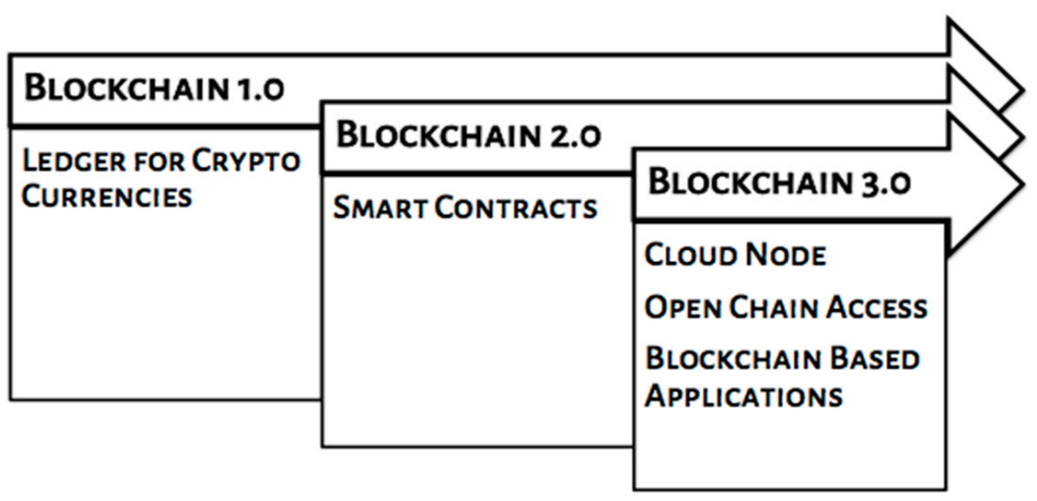
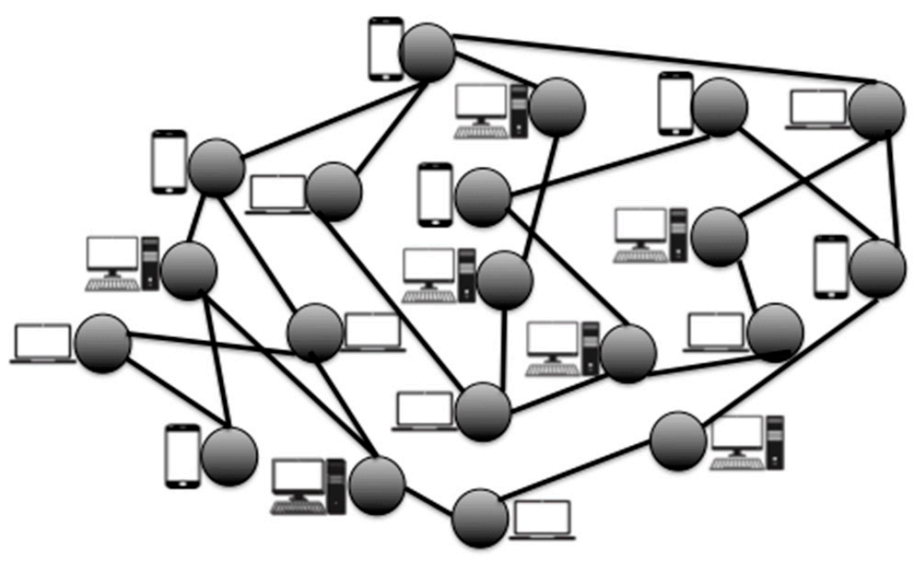


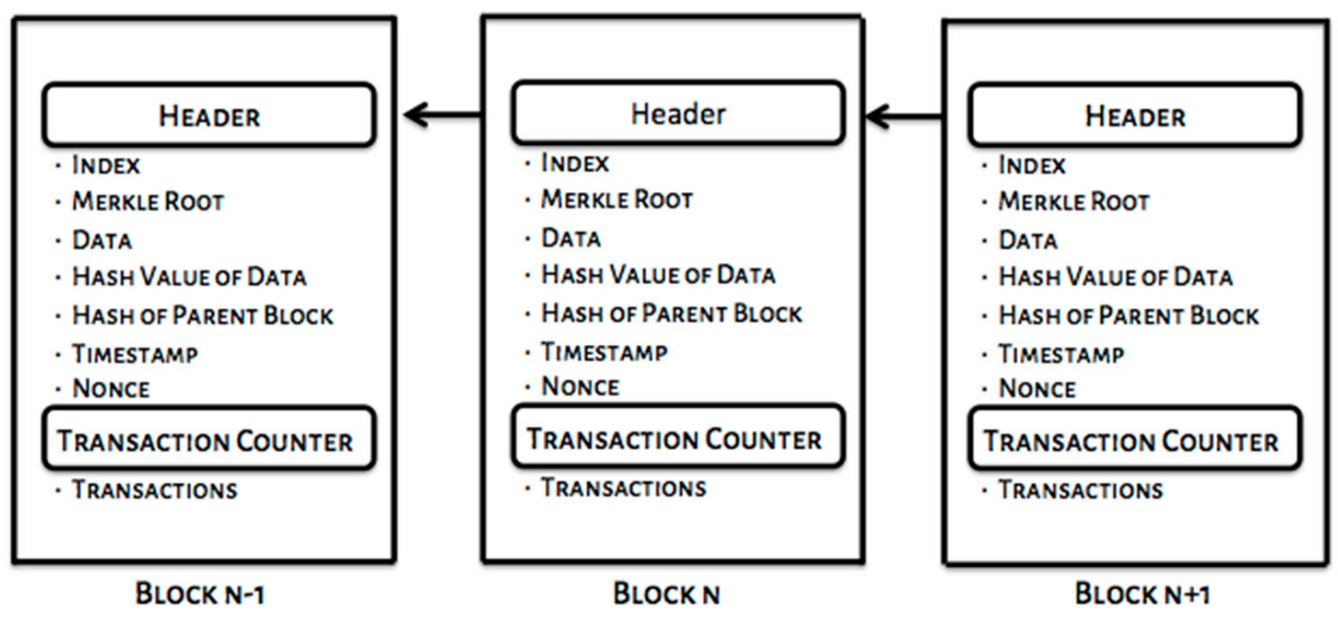

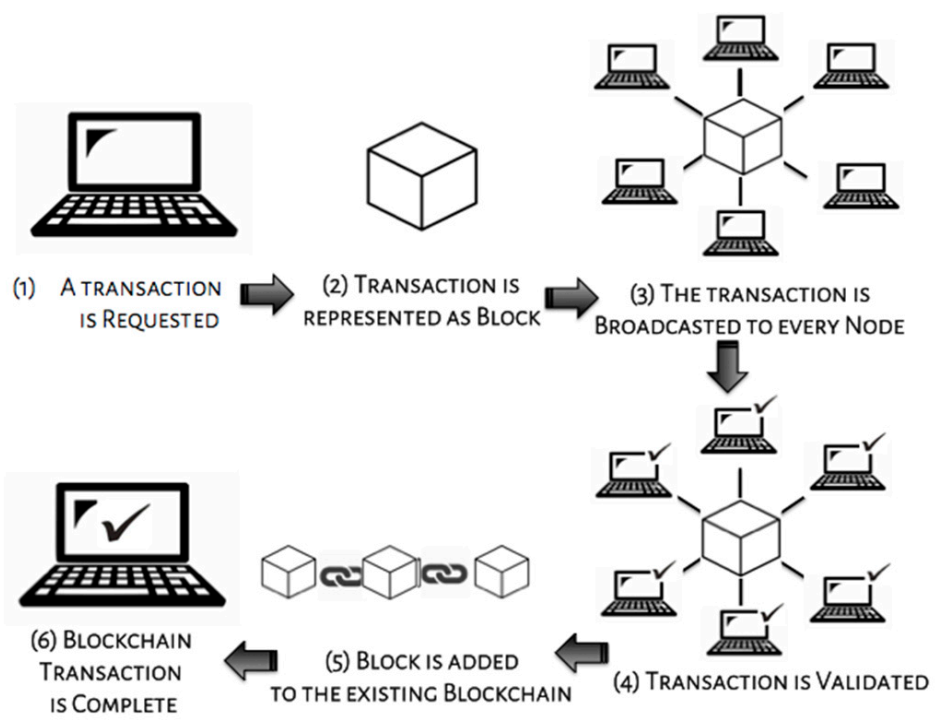
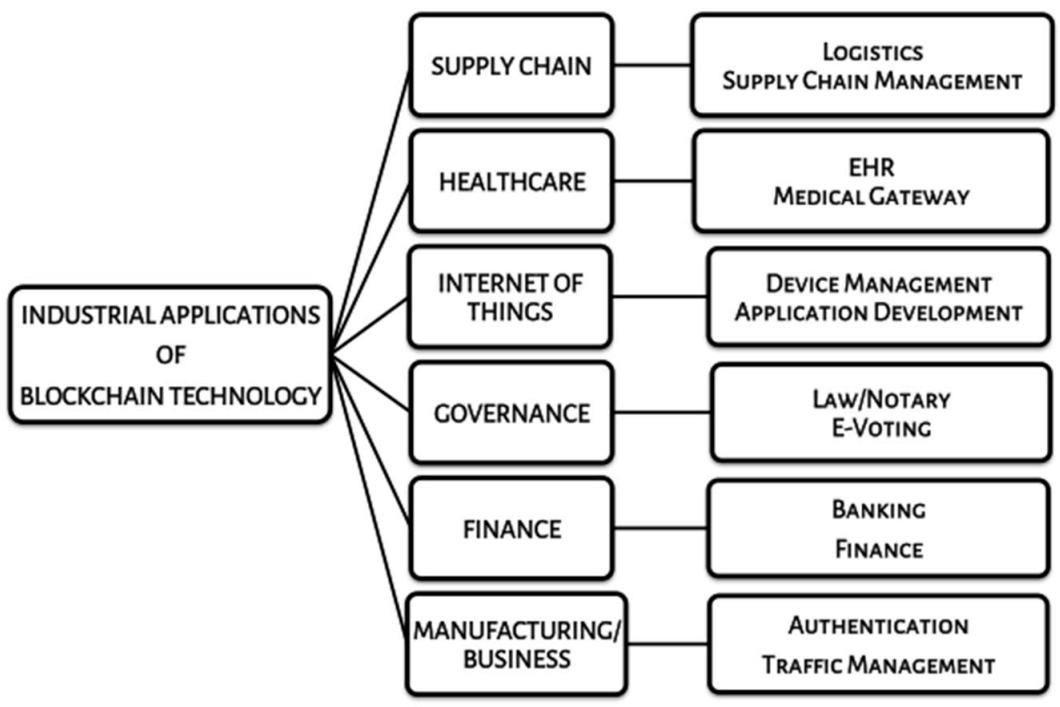
| Challenges | Possible Solutions |
|---|---|
| Counterfeit products leading to poor customer satisfaction [37] | Tamper-proof records and transactions [37] |
| Difficult tracking of products [94] | Time stamping enabled tracking of products [94] |
| Authentication dependency on documents [95] | Keeping records in immutable ledger [95] |
| Difficult tracking in real time [96] | Decentralized–Distributed ledger for efficiency [96] |
| Challenges | Possible Solutions |
|---|---|
| Sharing of Electronic Health Records (EHRs) [105] | Access control mechanisms [105] |
| Handling voluminous and complex data [106] | Immutable data records [106] |
| Inconsistency and heterogeneity in data [107] | Linking multiple data files to a single patient [107] |
| Data confidentiality and security [108] | Actual information is replaced by hash keys that point towards the location of data [108] |
| Counterfeit drugs [109] | Immutable and Time-Stamped transactions to track dealers and manufacturers [109] |
| Challenges | Possible Solutions |
|---|---|
| Maintenance of large number of devices [118] | Peer-to-Peer connection [118] |
| Attacks on central storages [119] | Data distributed among the nodes of the network [119] |
| Risk of forging [120] | Consensus mechanisms [120] |
| Challenges | Possible Solutions |
|---|---|
| Selling/Renting property [130] | Immutable and Time-Stamped transactions to track and manage assets [130] |
| Notary/Attestation [131] | Secure automated mechanisms following consensus protocols [131] |
| Citizen identity data management [132] | Actual information is replaced by hash keys that point towards the location of data [132] |
| Challenges | Possible Solutions |
|---|---|
| Digitization of currencies [140] | Distributed–Decentralized secure network with time-stamped immutable transactions [140] |
| Handling assets transmission [141] | Immutable and Time-Stamped transactions to track and manage assets [141] |
| Managing guidelines and regulations [140] | Secure automated mechanisms for implementing consensus protocols [140] |
| Challenges | Possible Solutions |
|---|---|
| Data breach, leak, theft, eavesdropping, unauthorized access [146] | Distributed secure network, time-stamped immutable ledger [146] |
| Human intervention [147] | No third-party involvement [147] |
| Physical transactions [147] | Integration with automatic verified billing, transparency [147] |
Publisher’s Note: MDPI stays neutral with regard to jurisdictional claims in published maps and institutional affiliations. |
© 2021 by the authors. Licensee MDPI, Basel, Switzerland. This article is an open access article distributed under the terms and conditions of the Creative Commons Attribution (CC BY) license (https://creativecommons.org/licenses/by/4.0/).
Share and Cite
Idrees, S.M.; Nowostawski, M.; Jameel, R.; Mourya, A.K. Security Aspects of Blockchain Technology Intended for Industrial Applications. Electronics 2021, 10, 951. https://doi.org/10.3390/electronics10080951
Idrees SM, Nowostawski M, Jameel R, Mourya AK. Security Aspects of Blockchain Technology Intended for Industrial Applications. Electronics. 2021; 10(8):951. https://doi.org/10.3390/electronics10080951
Chicago/Turabian StyleIdrees, Sheikh Mohammad, Mariusz Nowostawski, Roshan Jameel, and Ashish Kumar Mourya. 2021. "Security Aspects of Blockchain Technology Intended for Industrial Applications" Electronics 10, no. 8: 951. https://doi.org/10.3390/electronics10080951
APA StyleIdrees, S. M., Nowostawski, M., Jameel, R., & Mourya, A. K. (2021). Security Aspects of Blockchain Technology Intended for Industrial Applications. Electronics, 10(8), 951. https://doi.org/10.3390/electronics10080951








